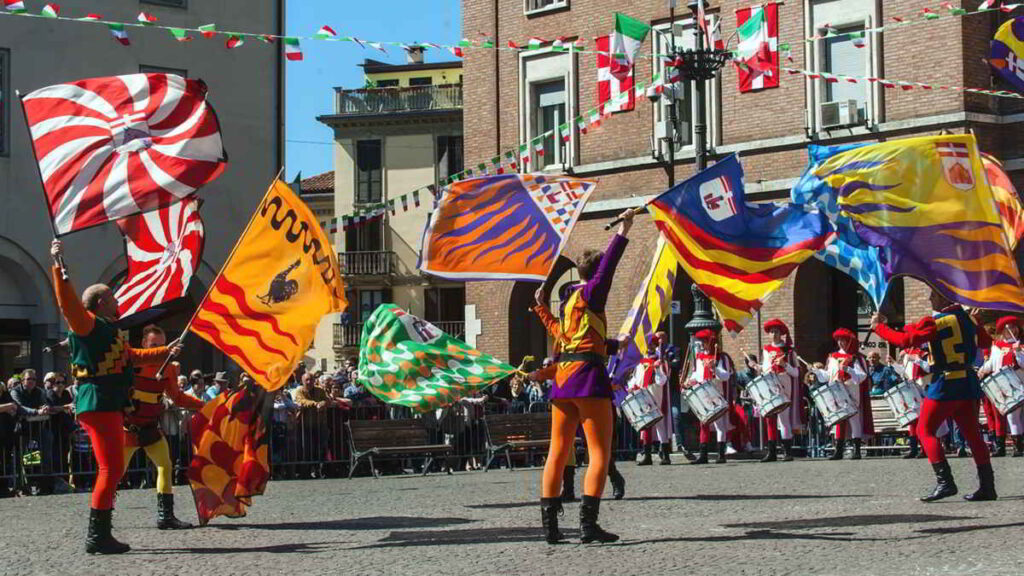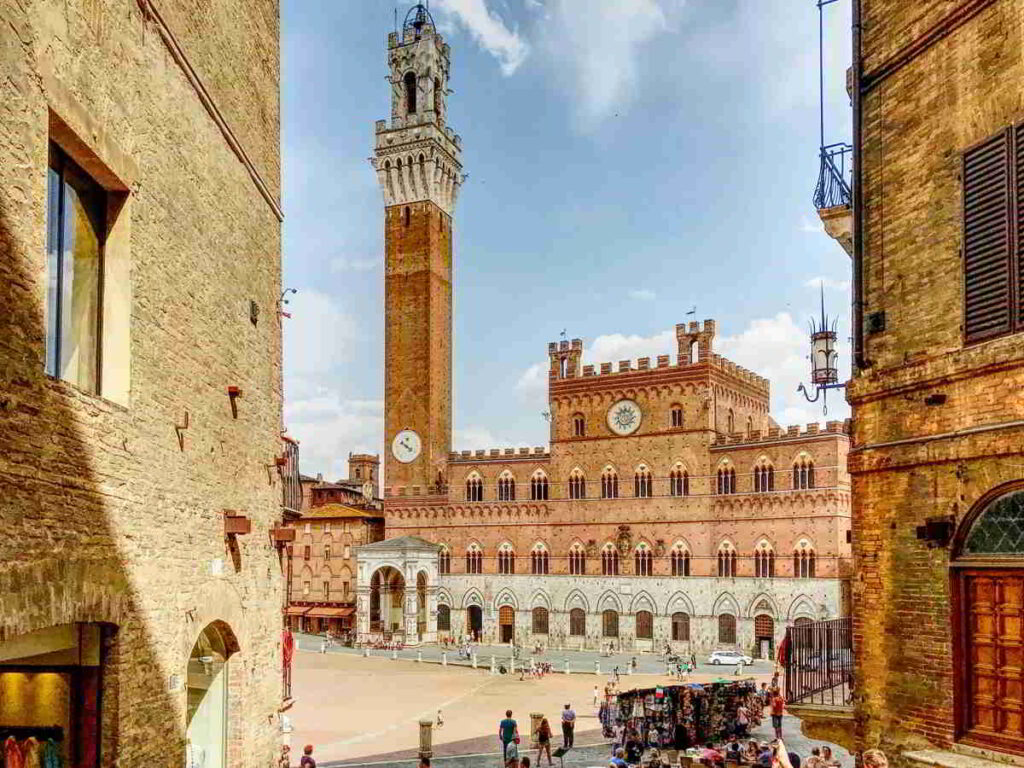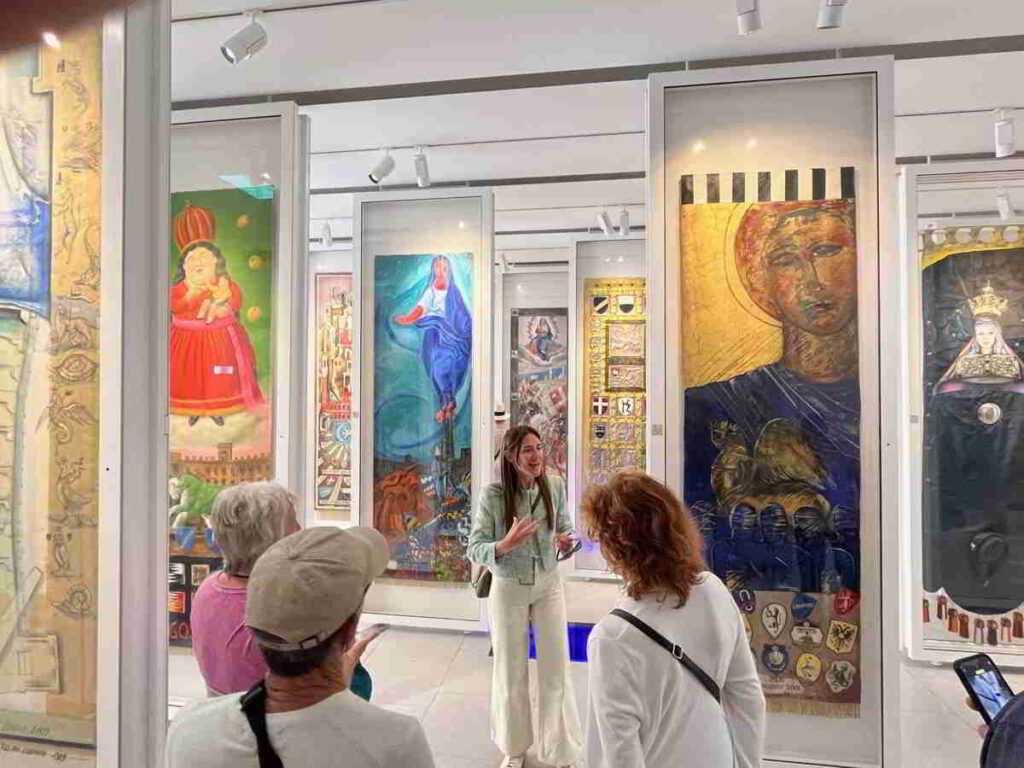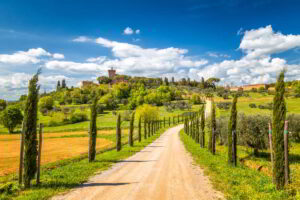Differences and Shared Traits of Siena’s Palio Horse Race and Palio of Asti
The Palio horse races in Siena and Asti are among Italy’s most renowned historic events, featuring vibrant reenactments with hundreds of participants in medieval costumes, flag throwers, superstitious customs, blessings for horses in churches, and lively street celebrations.
The Palio stands out as one of Italy’s most visually striking and captivating social events, whether it’s part of a Tuscany or Piedmont tour vacation package. While both races have connections in certain traditions, they differ in their origins, settings, race formats, and customs.
Siena, famous for its long-standing rivalry with Florence, retains a medieval charm thanks to its preservation from WWII bombings. It is a must-visit when exploring Italy with a tour vacation package , showcasing breathtaking architecture, such as one of the country’s most beautifully adorned cathedrals and the historic square where the Palio is hosted.
Asti, nestled in the heart of Piedmont’s esteemed wine region, is renowned for its wines such as the red Barbera d’Asti, aged Nizza, and the famous Asti Spumante. Although Asti enjoyed two centuries of power, minting its own coins from the 12th to the mid-14th century, it eventually lost its independence.
Under the House of Savoy’s influence, the city fell into the shadows of Turin, now embodying the essence of a tranquil Italian provincial town.
What is the Palio Horse Race?
Palio is a traditional Italian bareback horse race between city districts. Various smaller races exist throughout Italy, each with unique rules, such as the Legnano race or Alba’s Palio, which features donkeys instead of horses.
The word ‘palio‘ derives from the Latin term ‘pallium,’ translating to “cloth” or “banner,” which serves as the prize. Each year, an artist commissioned by the City Halls of Asti and Siena paints this banner on velvet or silk. While artists have some creative freedom, they must incorporate certain traditional elements, regardless of their style.
For Asti’s Palio, these elements include San Secondo, the city’s patron saint depicted as a Roman soldier, the coats of arms of the competing districts, and symbolic medieval representations like a rooster, alongside the city’s white and red flag, among others.
In Siena, the Palio must feature the Virgin Mary, as the race honors her. Historically, the city collaborates with notable artists, exemplified by the partnership with Botero in 2002, famous for his distinctive, rounded portrayals of humans and animals.

Historical Origins of Siena and Asti Palio Horse Races
The origins of these horse races are difficult to trace due to a significant lack of documentation. It is believed that during medieval times, when cities were protected by defensive walls, residents near a specific section of these walls were summoned to assist during attacks.
Thus, we can infer that the Palio began as a competition among various city districts—or sections of the walls—designed to determine the most powerful area while also documenting the alliances and rivalries among neighborhoods.
Asti claims to host Italy’s oldest Palio, with the earliest reference to such a horse race appearing in a 1275 document by local historian Guglielmo Ventura. This event celebrated Asti’s victory over its long-time foe, Alba, marked by a race run beneath Alba’s city walls, resulting in damage and destruction.
For centuries, Alba and Asti have been rivals, vying for control of the Tanaro River valley, a critical communication route in medieval Piedmont. This medieval rivalry stemmed from the ambitions of independent city-states to conquer local territories.
In Siena, the first documented Palio horse race is recorded only in 1633, however, documents dating from the 11th century mention a Palio in honor of San Bonifazio, the patron saint of the ancient cathedral of Castelvecchio used before the current one was built.
When visiting Italy through a tour vacation package, the uncertainty of the Middle Ages, the absence of roads and infrastructure, and the emergence of castles and defensive structures— are elements prevalent across many regions. For example, it reflects the tumultuous relationships seen in Tuscany between Florence and Siena or Florence and Pisa. This historic timeframe is also the main focus of Piedmont’s Castles & Abbeys Tour.
Under this point of view, Siena and Asti share the same historical background.
Track-Facts and Different Settings for Asti and Siena’s Palio
Siena and Asti dedicate substantial funds and time to their respective Palio events, which significantly disrupt the daily routines of residents. This is because the public spaces where the races take place must be closed to traffic and prepared at least two weeks in advance.
Both Siena’s Palio horse race and the Palio of Asti occur in centrally-located squares that are transformed into enclosed arenas for the occasion. A thick layer of tuff sands is transported by trucks, layered, and compacted. It is sourced from Tuscany’s rolling hills for Siena and from Piedmont’s Monferrato Hills for Asti.
The average sand depth is 15 cm (6 in) and the track length measures 339 meters (1100 ft) in Siena, slightly longer in Asti. Siena’s shell-shaped square known as Il Campo is situated on an incline, presenting a challenging course for the Palio race, with some sections uphill, others downhill, and two sharp turns where jockeys frequently fall, risking injury.
Asti’s Piazza Alfieri, on the contrary, is flat but, like Siena, has sharp turns.
Surrounding the track, grandstands are erected for the audience, necessitating the removal of outdoor tables from Siena’s local cafés and restaurants, while in Asti, local parking areas and adjacent streets are closed.
Siena’s Campo, a Italy Tour Vacation Package’s Must-See
The beauty of the Campo, the medieval square hosting Siena’s Palio horse race, is remarkable and a must-see on an Italy tour vacation package, such as our Grand Tour of Tuscany.
In Italian, “campo” means field, as this square was once the largest unpaved space in Siena. Today, it serves as the city’s main gathering spot and a landmark, celebrated as one of Italy’s most beautiful squares, showcasing the city’s wealth and power through the elegant facades of the medieval buildings surrounding it.
Additionally, the Campo features the City Hall and the adjacent Torre del Mangia, named after Giovanni di Balduccio, known by the nickname “Mangiaguadagni” (“Profit Eater”) for reportedly spending his entire earnings on food. This tower, constructed between 1338 and 1348, reaches a height of 88 meters (289 feet), making it one of the tallest secular towers in medieval Italy.
For centuries, Siena has consistently used the same square for the Palio, with races only suspended during wartime, the Napoleonic invasion, and the recent Covid epidemic. The city takes great pride in this enduring tradition, which serves as a stable and comforting event in the lives of its residents.

Palio of Asti Historical Evolution and Locations
In contrast, Asti had prolonged periods during which the horse race was halted and likely forgotten.
Asti’s original Palio was conducted “alla lunga,” referring to a lengthy straight route along the high street, Corso Alfieri, with the finish next to the Comentina Tower, a tall medieval structure attached to a monastery, located in what is now Piazza Roma.
In 1861, a new square was established for the market, known today as Campo del Palio, though it does not align with the current race location. From that point, the Palio of Asti diminished into a mere horse race, lacking heraldic relevance, resembling more of a horse exhibition than a historically significant event.
In 1929, under Fascism, the Palio of Asti briefly regained its grandeur but moved location running uphill along Corso Dante. It wasn’t until 1931 that the historical parade featuring costumed participants made its debut in Asti, with costumes styled from the 1500s, intended to honor the House of Savoy, the ruling family of Italy at that time.
Yet in 1935, Fascist authorities prohibited Asti from using the term Palio, reserving it solely for Siena.
This decision demoralized Palio supporters and organizers in Asti, leading to the event’s suspension until 1966, when it returned to Campo del Palio before relocating to Piazza Alfieri in 1988.
While Asti boasts a spacious triangular square, its visual impact and frame in Piazza Alfieri pales in comparison to Siena’s Campo. Piazza Alfieri features two lengthy sides edged by elegant arcades characteristic of 19th-century Piedmontese architecture. In contrast, the third side is dominated by a large and less appealing concrete building from the 1960s, housing the provincial offices.

Asti and Siena’s Palio Horse Race City Districts
Siena hosts two races each year on July 2nd and August 16th, whereas the Palio of Asti occurs annually on the first Sunday of September.
In Siena, only ten of the seventeen Contrade participate in each race (seven by rotation and three drawn by lottery). In contrast, Asti has twenty-one contenders, comprising fourteen Rioni from the city and seven from surrounding towns scattered around the province.
The Asti race lasts most of the afternoon since not all horses can compete simultaneously. There are three groups of seven horses each, and in the fourth race, the three winners from the earlier heats face off in the final competition.
In both cities, the races are brief, lasting only a couple of minutes or even less, and consist of three clockwise laps. In Siena, the ten horses compete together in a single decisive race, resulting in a quicker show, while in Asti, the excitement carries on if a Rione wins one of the earlier groups, culminating in the final race.
Interestingly, some of Siena’s districts, called Contrade, are named after exotic animals that were not present in medieval Tuscany, such as the elephant (emblem of the Tower’s Contrada), and the Panther and Giraffe, as well as fantastical names like the Wave, Unicorn, and Dragon.
In contrast, the districts in Asti, known as Rioni, are named after major churches or local neighborhoods, like San Secondo, Cattedrale, and San Martino.
Asti and Siena’s Palio Horse Race Prizes
In Siena, the strict rules of the Palio leave no room for second-place celebrations. Essentially, the one who finishes second is seen as the first loser!
In contrast, Asti adopts a more generous approach by offering multiple prizes that decrease in significance. The second place receives a bag of silver coins, the third gets spurs, and then there’s a live rooster—a symbol of the medieval free Commune—and a cockade. The last place earns a salad topped with salted anchovies, a humorous reward that carries historical significance. For a long time, salted anchovies were the only available sea fish in Piedmont and served as natural flavor enhancers.
Additionally, the riders are professional jockeys who undergo extensive training to ensure peak physical condition for the race. They do not belong to any specific district and, except for a few rare cases, they aren’t locals from Siena or Asti. Their main goal is to position their horse strategically in the lead, whipping the competition if necessary. However, a shared rule between Siena and Asti dictates that the horse is the true winner, even if the jockey falls.
This means that if a jockey falls during the race—particularly during one of the sharp turns on the tracks in Siena and Asti—but the horse keeps going, without losing the district’s coat of arms attached to its head, it still wins.
Italy Tour Vacation Package with a Contrada Museum in Siena
The champion is awarded the coveted Palio—a hand-painted banner that is paraded through town for weeks or months following the victory, often mocking the enemies. Afterwards, the won Palio is preserved in the district’s museum, alongside old costumes, flags, and other memorabilia.
Accessing one of Siena’s Contrada museums can be challenging, as they are typically not open to the public. However, on our Grand Tour of Tuscany, our small group gains unique access to these exclusive spaces, witnessing firsthand where preparations for the next Palio happen and discovering the profound sense of cohesion and passion the locals possess.

Tuscany and Piedmont’s Traditions, Superstition and Celebrations
Whether it’s Tuscany’s charming city of Siena or Piedmont’s quiet city of Asti, the days of the Palio horse race are deeply-rooted in traditions. They bring the entire community together in a celebration of local heritage and pride.
The race itself is a thrilling spectacle, featuring bareback riders representing various districts of the city, each vying for glory in a high-stakes competition. The atmosphere is electric, with the entire city coming alive with parades, pageantry, and a palpable sense of excitement that transcends generations.
Palio’s historical significance is deeply intertwined with the city’s identity. In medieval times, the palio was a means of demonstrating power and prestige among the noble families of Siena and Asti. Over the centuries, it has evolved into a symbol of communal pride, reflecting the resilience and spirit of the people.
The festivities begin well before the race day, with each district, Contrada in Siena and Rione in Asti, prepare elaborate costumes, floats, and banners. Musicians rehearse for months as they have to march and play simoultaneously and flag throwers prepare intricate choreography that often requires acrobatic skills.
In Siena, most residents actively participate as volunteers in different shape and forms, whether it’s sewing costumes or contribuiting to the logistics. Most of them are estimated to donate, throughout their life, several thousand of Euros in donations or time spent working.
In Asti the passion is similar but probably more contained and limited to a small circle of people.
In both cities, the preparation begins months in advance. When a Palio is won, just a few days pass by before next year’s race goes into planning.
Celebrations and Events before the Palio’s Race
One of the highlights of the Palio of Asti is the solemn blessing of the horses and riders, which takes place in the morning before the race. This ceremony, held in the city’s cathedral, is a poignant reminder of the deep spiritual connection that underpins the event. The jockeys and their horses receive a blessing for safety and success, a tradition that underscores the reverence with which the palio is regarded. It is a moment of quiet reflection and anticipation before the excitement of the race.
In Siena, the same ceremony takes place in each Contrada’s church. If the horse poops on the church floor during the blessing, is considered a sign of good luck|
The night before the race is held, propitiatory dinners are organized by each city district, in both Asti and Siena. These dinners consist of long tables arranged down the streets and sit hundreds of people. The food is prepared by the volunteers of each district, and it is usually possible to join by paying a fee. It is a convivial, rustic but passionate gathering where singing or mocking the district’s enemy is considered normal.
Unveiling Siena and Asti Local Traditions
The Siena Palio horse race is renowned internationally, drawing thousands of visitors to Tuscany and being broadcast globally. Although the Palio of Asti is historically older, it is less recognized yet remains an important cultural event in Piedmont.
Both events are steeped in history, featuring rituals and traditions that extend beyond the horse races themselves. They provide unique chances to explore local customs, and hearing locals explain them is an added value of any Italy tour vacation package.
If you seek fierce rivalries, strategic intensity, and a wild yet exhilarating race, the Palio of Siena offers all that. Enduring July and August’s sun all afternoon while waiting for the race can be physically demanding. Visiting a Contrada museum privately is possible year-round and fosters connections with locals.
For enthusiasts of medieval history, pageantry, and a less aggressive atmosphere, the Palio of Asti is ideal, best enjoyed alongside a wine tour of Piedmont’s vineyards.
Both are remarkable historical events, each brimming with its own spirit and traditions! For those lucky enough to experience the Palio in Siena or Asti, it provides an unforgettable glimpse into the heart of these enchanting Italian cities.






